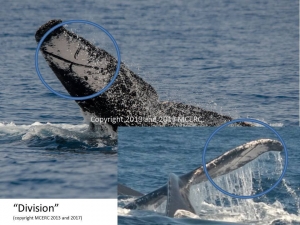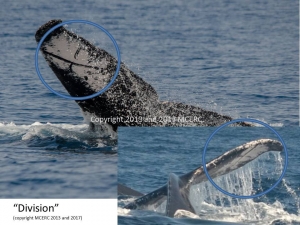
MCERC Puerto Rico Citizen Science
Humpback Whale Project

What is this photo showing? Hover to learn!
This image demonstrates the “photographic capture-recapture” of the whale “Division”, photographed in 2011 off Puerto Rico (top) and off the Turks and Caicos Islands in 2013 (bottom right) by Dr. Mithriel MacKay!
Citizen Scientists continue to be valuable partners in research. MCERC provides a gateway for people in Puerto Rico,USA to contribute to ongoing research with our team in the Caribbean by submitting their images of marine megafauna with a focus on humpback whales (Megaptera novaeangliae). You can read more about the MCERC Biodiversity Project here.
How you can contribute
Do you have photos of humpback whales taken in Puerto Rican waters? Contribute them to MCERC's ongoing research!
About - Humpback Whale Migration
Humpback whales migrate to the Caribbean during the winter months for breeding and calving. They are occasionally harassed by pilot whales, accompanied by dolphins, and share areas with surfers, fishers, and boaters. Mothers with calves often rest quietly at the start of the winter; however, as the calves grow (quickly!) they become increasingly active.
The Puerto Rico Whale Experience
It is common to spot whales as they slap the water with flippers and flukes or jump high in the air near shore. Although there is not a “best time of the day” to see whales from shore, Rincón and the northwest between Aguadilla to San Juan are prime spotting locations - you often won't even need binoculars! Whales and dolphins are in the waters all around the archipelago; however, some species prefer the deeper waters and are not as readily available from the land.
How you can contribute
Do you have photos of humpback whales taken in Puerto Rican waters? Contribute them to MCERC's ongoing research!
About - Humpback Whale Migration
Humpback whales migrate to the Caribbean during the winter months for breeding and calving. They are occasionally harassed by pilot whales, accompanied by dolphins, and share areas with surfers, fishers, and boaters. Mothers with calves often rest quietly at the start of the winter; however, as the calves grow (quickly!) they become increasingly active.
The Puerto Rico Whale Experience
Although there's not a “best time” to see whales from shore, Rincón & the northwest between Aguadilla to San Juan are prime spotting locations - you often won't even need binoculars! Eco tours also have excursions in the near-shore waters where humpback whales are seen. “Capi” Michael Lopez (Deep Adventure Tours) has been the primary captain for MCERC research since 2012 & Captain Jeffrey Albrecht is our support boat for when Capi is working with the search and rescue teams from the US Coast Guard.
How we do it:
Images are added to the MCERC database, the Happy Whale catalog, and Allied Whale catalogs where they are matched to photos submitted by all contributors. The collaboration between all the organizations and citizens involved are included in the analysis towards a better understanding of humpback whale life history. MCERC has been collecting data off Puerto Rico since 2009. The generous contributions made exclusively to this project are especially important because the additional eyes and images are able to observe more whales throughout the winter than our team can study alone.
It’s exciting to find matches within and between the catalogs! MCERC’s research team confirms the matches and then posts the news to the social media and websites set up to share the places the whales have been photographed and the length of time between sightings. The matches include whales observed and photographed off the feeding grounds in the higher latitudes in the North Atlantic to Puerto Rico with decades between sightings, as well as sightings within the same year between other islands throughout the Caribbean.
The MCERC Education Hub conducts programs around the globe, including the Humpback Whale Field Intensive Program. If you would like more information about joining our team in the field for day excursions, kayaking trips, research programs, and workshops, please browse the MCERC Education Hub for opportunities to suit your interest.
MCERC has three citizen science programs with dedicated FaceBook pages. These pages are where people follow the contributions and hear about the matches very quickly. All photographs remain the property of the photographer, have granted MCERC exclusive rights to be used for research and education, and are submitted to the larger catalogs by MCERC scientists on behalf of the photographers.
Announcements and updates about our research are often posted on social media. You can follow us here:

Citizen Scientists continue to be valuable partners in research. MCERC provides a gateway for people in Puerto Rico,USA to contribute to ongoing research with our team in the Caribbean by submitting their images of marine megafauna with a focus on humpback whales (Megaptera novaeangliae). You can read more about the MCERC Humpback Whale Project here. The photo to the left demonstrates the “photographic capture-recapture” of “Division”, photographed in 2011 off Puerto Rico (top) and off the Turks and Caicos Islands in 2013 (bottom right) by Dr. Mithriel MacKay.
Humpback whales migrate to the Caribbean during the winter months for breeding and calving. They are occasionally harassed by pilot whales, accompanied by dolphins, and share areas with surfers, fishers, and boaters. Mothers with calves often rest quietly at the start of the winter; however, as the calves grow (quickly!) they become increasingly active. It is common to spot whales as they slap the water with flippers and flukes or jump high in the air near shore. Although there is not a “best time of the day” to see whales from shore, Rincón and the northwest between Aguadilla to San Juan are prime spotting locations. Binoculars are not necessary to see whales from these locations! Whales and dolphins are in the waters all around the archipelago; however, some species prefer the deeper waters and are not as readily available from the land.
Eco tours often have excursions in the same near-shore waters that humpback whales are observed. MCERC’s own “Capi” Michael Lopez (Deep Adventure Tours) is the primary captain for our research team since 2012 and Jeffrey Albrecht (Seven Seas Fishing Excursions) is our support boat for research when Capi is working with the search and rescue teams from the US Coast Guard.
Images are added to the MCERC database, the Happy Whale catalog, and Allied Whale catalogs where they are matched to photos submitted by all contributors. The collaboration between all the organizations and citizens involved are included in the analysis towards a better understanding of humpback whale life history. MCERC has been collecting data off Puerto Rico since 2009. The generous contributions made exclusively to this project are especially important because the additional eyes and images are able to observe more whales throughout the winter than our team can study alone.
It’s exciting to find matches within and between the catalogs! MCERC’s research team confirms the matches and then posts the news to the social media and websites set up to share the places the whales have been photographed and the length of time between sightings. The matches include whales observed and photographed off the feeding grounds in the higher latitudes in the North Atlantic to Puerto Rico with decades between sightings as well as sightings within the same year between other islands throughout the Caribbean.
Whether you are interested in following the Puerto Rico Humpback Whale Project or want to contribute images to the MCERC catalog, you can follow this project on FaceBook by liking the Puerto Rico Humpback Whale Sightings Page and contribute your photos of whales and dolphins from the waters surrounding Puerto Rico!
